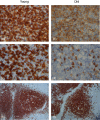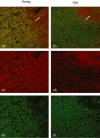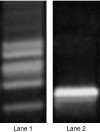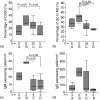Age-related loss of naïve T cells and dysregulation of T-cell/B-cell interactions in human lymph nodes - PubMed (original) (raw)
Age-related loss of naïve T cells and dysregulation of T-cell/B-cell interactions in human lymph nodes
Lutfan Lazuardi et al. Immunology. 2005 Jan.
Abstract
In this study we analysed the effects of age on T and B lymphocytes in human lymph nodes by comparing lymphocyte subsets in paraffin sections from lymph node tissue taken from healthy young and elderly people. We demonstrate that the relative number of CD8(+) T cells decreases with age but that the relative number of CD4(+) T cells does not. There is also a very pronounced age-dependent loss of CD45RA(+) naive T cells. The number and size of follicles and the relative number of CD20(+) B cells are similar in young and elderly donors. For polymerase chain reaction analysis of the T-cell receptor (TCR) repertoire the TCR-gamma gene rearrangements were used as a marker of clonality. This is a reliable tool to detect not only clonal TCR-gammadelta populations but also TCR-alphabeta populations. Young donors with clonal T-cell expansions in their lymph node tissue do, however, have a higher number of CD20(+) B cells, a higher relative size of germinal centres compared to the follicle mantles and a higher number of immunoglobulin M-expressing cells than young donors without evidence of clonal T-cell expansions. Corresponding changes are not observed in elderly donors with clonal T-cell expansions in their lymph node tissue. In summary our findings demonstrate characteristic effects of aging on human lymph node tissue, the most striking feature being the depletion of naive T cells and the apparent dysregulation of T-cell/B-cell interactions in old age.
Figures
Figure 1
Immuperoxidase stainings of paraffin-embedded tissue. CD4-positive (a, b) and CD8-positive (c, d) cells in the paracortex area of lymph nodes from young (a, c) and old (b, d) donors; original magnification ×400. CD20-positive cells (e, f) which are predominantly located in follicles in young (e) and old (f) donors; original magnification ×40.
Figure 2
Immunofluorescence stainings of paraffin sections of lymph nodes. Stainings were performed with antibodies to CD3 (green) and CD45RA (red) and were analysed by confocal microscopy. Double-positive cells showed a mixed yellow colour. Lymph nodes from young people (a) contained more CD45RA+ CD3+ cells than lymph nodes from elderly people (b). A follicle which contains CD45RA (red) single-positive B cells is indicated by the white arrow. The red and the green channels of the same region are separately demonstrated in (c) to (f): (c, e) young donor, (d, f) old donor; original magnification ×200.
Figure 3
Restriction fragment length polymorphism analysis showing multiple smearing bands (lane 1) indicating a lack of dominant T-cell clones and a single band (lane 2) indicating the presence of a clonal T-cell population. Examples of lymph node tissue from one young person and from one elderly person are shown.
Figure 4
The box plots show the percentage of CD20-expressing cells (a), the proportion of the size of the germinal centre to the mantle zone area (b) as well as the numbers of IgM-expressing (c) and IgG-expressing (d) cells per mm2 based on age groups as well as the presence or absence of clonal T-cell expansions: A–B, lymph nodes from young people, B–D, lymph nodes from elderly people; A and C without clonal expansion, B and D with clonal expansion.
Similar articles
- Age-dependent accumulation of monoclonal CD4+CD8+ double positive T lymphocytes in the peripheral blood of the elderly.
Ghia P, Prato G, Stella S, Scielzo C, Geuna M, Caligaris-Cappio F. Ghia P, et al. Br J Haematol. 2007 Dec;139(5):780-90. doi: 10.1111/j.1365-2141.2007.06867.x. Br J Haematol. 2007. PMID: 18021092 - Analysis of clonal CD8+ T cell expansions in normal individuals and patients with rheumatoid arthritis.
Fitzgerald JE, Ricalton NS, Meyer AC, West SG, Kaplan H, Behrendt C, Kotzin BL. Fitzgerald JE, et al. J Immunol. 1995 Apr 1;154(7):3538-47. J Immunol. 1995. PMID: 7897233 - Postthymic development of CD28-CD8+ T cell subset: age-associated expansion and shift from memory to naive phenotype.
Nociari MM, Telford W, Russo C. Nociari MM, et al. J Immunol. 1999 Mar 15;162(6):3327-35. J Immunol. 1999. PMID: 10092786 - Inducing the T cell fates required for immunity.
Reiner SL. Reiner SL. Immunol Res. 2008;42(1-3):160-5. doi: 10.1007/s12026-008-8054-9. Immunol Res. 2008. PMID: 18806935 Review.
Cited by
- Development of an epigenetic clock resistant to changes in immune cell composition.
Tomusiak A, Floro A, Tiwari R, Riley R, Matsui H, Andrews N, Kasler HG, Verdin E. Tomusiak A, et al. Commun Biol. 2024 Aug 2;7(1):934. doi: 10.1038/s42003-024-06609-4. Commun Biol. 2024. PMID: 39095531 Free PMC article. - Effects of immune exhaustion and senescence of innate immunity in autoimmune disorders.
Cunha ALS, Perazzio SF. Cunha ALS, et al. Braz J Med Biol Res. 2024 Jun 17;57:e13225. doi: 10.1590/1414-431X2024e13225. eCollection 2024. Braz J Med Biol Res. 2024. PMID: 38896644 Free PMC article. Review. - Vaccines against extraintestinal pathogenic Escherichia coli (ExPEC): progress and challenges.
Qiu L, Chirman D, Clark JR, Xing Y, Hernandez Santos H, Vaughan EE, Maresso AW. Qiu L, et al. Gut Microbes. 2024 Jan-Dec;16(1):2359691. doi: 10.1080/19490976.2024.2359691. Epub 2024 Jun 2. Gut Microbes. 2024. PMID: 38825856 Free PMC article. Review. - A multi-organ map of the human immune system across age, sex and ethnicity.
Mangiola S, Milton M, Ranathunga N, Li-Wai-Suen C, Odainic A, Yang E, Hutchison W, Garnham A, Iskander J, Pal B, Yadav V, Rossello J, Carey VJ, Morgan M, Bedoui S, Kallies A, Papenfuss AT. Mangiola S, et al. bioRxiv [Preprint]. 2024 Apr 29:2023.06.08.542671. doi: 10.1101/2023.06.08.542671. bioRxiv. 2024. PMID: 38746418 Free PMC article. Preprint. - Metabolic imbalance driving immune cell phenotype switching in autoimmune disorders: Tipping the balance of T- and B-cell interactions.
Barberis M, Rojas López A. Barberis M, et al. Clin Transl Med. 2024 Mar;14(3):e1626. doi: 10.1002/ctm2.1626. Clin Transl Med. 2024. PMID: 38500390 Free PMC article.
References
- Gavazzi G, Krause KH. Ageing and infection. Lancet Infect Dis. 2002;2:659–66. - PubMed
- Grubeck-Loebenstein B, Berger P, Saurwein-Teissl M, Zisterer K, Wick G. No immunity for the elderly. Nat Med. 1998;4:870. - PubMed
- Linton PJ, Dorshkind K. Age-related changes in lymphocyte development and function. Nat Immunol. 2004;5:133–9. - PubMed
- Beverley PC, Grubeck-Loebenstein B. Is immune senescence reversible? Vaccine. 2000;18:1721–4. - PubMed
- Grubeck-Loebenstein B, Wick G. The aging of the immune system. Adv Immunol. 2002;80:243–84. - PubMed
Publication types
MeSH terms
Substances
LinkOut - more resources
Full Text Sources
Other Literature Sources
Medical
Research Materials
Miscellaneous



